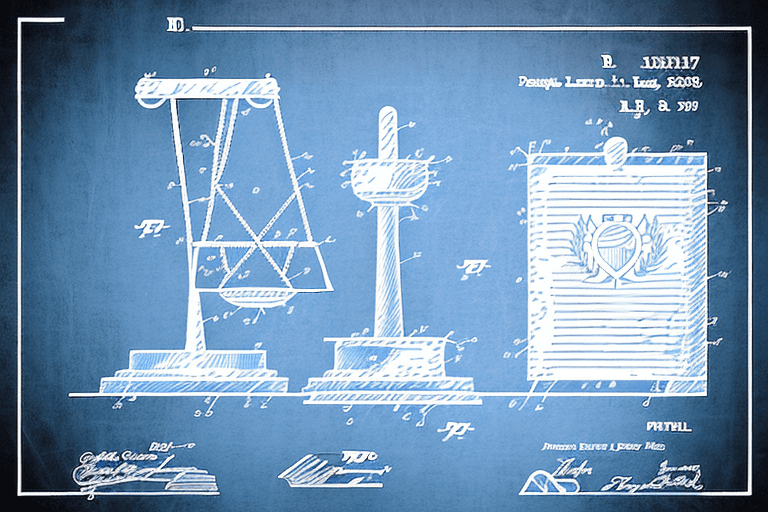In the world of intellectual property, a patent is a highly valuable asset that offers exclusive rights to an inventor or assignee for a certain period of time. However, there may be instances where these rights need to be enforced or protected. This is where the concept of an injunction comes into play. In this comprehensive article, we will take a deep dive into injunctions, patents, the Manual of Patent Examining Procedure (MPEP), and the significance of the Patent Bar.
Understanding the Concept of Injunction
At its core, an injunction is a legal remedy that is sought in order to prohibit someone from engaging in certain activities or to compel them to perform specific actions. In the context of patents, an injunction is a court order that restrains a party from manufacturing, selling, or using a product that infringes on a valid patent. It serves as a powerful tool to protect the patent holder’s exclusive rights and can be used to prevent economic harm or irreparable damage from occurring.
An injunction is an essential aspect of patent law as it allows inventors and assignees to prevent others from unlawfully using or benefiting from their patented inventions. It acts as a deterrent against infringement and serves as a means for patent holders to exercise control over their protected intellectual property.
Definition and Importance of Injunction
Before delving into the various types of injunctions in patent law, let’s first understand the definition and importance of an injunction. In simple terms, an injunction is a court order that either prohibits or compels a party to take certain actions.
In the context of patent law, an injunction is crucial for patent holders as it allows them to enforce their exclusive rights and prevent others from using, selling, or profiting from their patented inventions without authorization. This provides inventors and assignees with the assurance that their hard work, creativity, and innovation will be protected and respected.
Types of Injunctions in Patent Law
When it comes to patent law, there are various types of injunctions that can be sought depending on the circumstances and nature of the infringement. These include:
- Preliminary Injunctions: These are temporary injunctions that can be sought during the early stages of a patent infringement lawsuit. They are designed to maintain the status quo until the court reaches a final decision.
- Permanent Injunctions: As the name suggests, permanent injunctions are court orders that are granted after a final decision has been made in a patent infringement case. They prohibit the infringing party from continuing the unlawful activities permanently.
- Provisional Injunctions: Provisional injunctions are sought in urgent situations where immediate action is required to prevent irreparable harm. They are temporary in nature and are granted before a formal hearing or trial takes place.
Each type of injunction serves a specific purpose and can be used strategically to protect the rights of patent holders. By seeking the appropriate type of injunction, patent holders can effectively prevent infringement and defend their intellectual property.
An In-depth Look at Patents
Before navigating the complexities of injunctions and the MPEP, it is important to have a solid understanding of what a patent entails and why it is so crucial in today’s innovation-driven world.
What is a Patent?
A patent is a legally recognized grant of exclusive rights provided to inventors or assignees for their novel and useful inventions. It provides a time-limited monopoly to the patent holder, preventing others from making, using, selling, or importing the patented invention without permission.
This exclusive right acts as an incentive for inventors and encourages innovation by allowing them to recoup their investments and reap the rewards of their ingenuity. It also serves as a valuable tool for economic growth and development.
The Process of Obtaining a Patent
Obtaining a patent involves a thorough and rigorous process to ensure that only truly novel and non-obvious inventions are granted protection. The process typically consists of the following steps:
- Patentability Search: Before proceeding with a patent application, it is essential to conduct a comprehensive patentability search to determine if the invention is truly novel and non-obvious. This helps avoid unnecessary expenses and provides insight into the patent landscape.
- Preparing the Patent Application: A well-drafted patent application is crucial for successful patent protection. The application must include a detailed description of the invention, its novel aspects, and its potential applications.
- Filing the Application: Once the patent application is prepared, it must be filed with the relevant patent office. This initiates the examination process.
- Patent Examination: The patent office examines the application to determine if the invention meets the patentability criteria. This involves reviewing prior art, assessing the novelty and non-obviousness of the invention, and evaluating its usefulness.
- Patent Grant: If the patent office determines that the invention meets all the necessary requirements, a patent is granted, providing the inventor or assignee with exclusive rights to their invention.
It is important to note that the process of obtaining a patent can be complex and time-consuming. However, the rewards of securing patent protection for a valuable invention are well worth the effort.
Importance of Patents in Innovation and Business
Patents play a crucial role in fostering innovation, driving economic growth, and enhancing competitiveness. By granting inventors and assignees exclusive rights to their inventions, patents incentivize further research and development, leading to groundbreaking technological advancements and improvements in various industries.
Furthermore, patents provide legal protection and create a favorable environment for businesses to invest in research and development activities. They enable companies to differentiate themselves from competitors, attract investors, and secure market share by capitalizing on their innovative products and technologies.
Overall, the patent system not only rewards inventors for their ingenuity but also contributes to the progress of society as a whole by encouraging continuous innovation and fostering a culture of creativity.
The Manual of Patent Examining Procedure (MPEP)
In order to navigate the complex world of patents effectively, patent practitioners and examiners rely on a comprehensive and authoritative resource known as the Manual of Patent Examining Procedure (MPEP).
Overview of the MPEP
The MPEP is a manual published by the United States Patent and Trademark Office (USPTO) that provides guidelines and procedures for patent examination. It serves as a valuable resource for patent examiners, patent attorneys, and inventors, offering detailed information on patent laws, regulations, and examination practices.
As an extensive document, the MPEP covers a wide range of topics, including patentability requirements, patent examination procedures, appeals, reexaminations, and other aspects of patent law. It is continuously updated to reflect changes in legislation and legal precedents, ensuring its relevance and accuracy.
Role of the MPEP in Patent Law
The MPEP plays a critical role in the patent examination process, providing uniformity and consistency in the evaluation of patent applications. It serves as a guide to patent examiners, offering a framework for assessing the patentability of inventions and ensuring that the examination process adheres to established legal standards.
In addition to its role in examination, the MPEP is also utilized by patent practitioners to understand the requirements for obtaining patents and to navigate the intricacies of the patent system. It acts as a valuable reference tool, providing insight into procedural matters, case law interpretations, and best practices for drafting and prosecuting patent applications.
How to Navigate the MPEP
Considering its vast size and complexity, navigating the MPEP can be a daunting task. However, there are a few key strategies that can help patent practitioners and inventors effectively utilize this invaluable resource:
- Search Functionality: The digital version of the MPEP allows users to search for specific keywords or phrases, making it easier to locate relevant information quickly. This feature proves to be a valuable time-saving tool, especially when dealing with specific sections or topics.
- Understanding the Structure: Familiarizing oneself with the organization and structure of the MPEP can greatly enhance navigation. The manual is divided into chapters and sections, each addressing specific aspects of patent examination and related procedures. Acquainting oneself with this organizational structure can streamline the search for relevant information.
- Supplemental Resources: The MPEP is a comprehensive resource, but it may not cover every scenario or address all unique situations. In such cases, relying on supplemental resources, such as legal treatises or expert opinions, can provide additional guidance and clarification.
By leveraging these strategies and understanding how to effectively navigate the MPEP, patent practitioners and inventors can optimize their use of this invaluable resource, ensuring that they have access to up-to-date information and guidelines.
The Patent Bar: A Crucial Step for Patent Practitioners
For those aspiring to become patent practitioners and represent inventors in matters related to patents, clearing the Patent Bar is an essential milestone.
Understanding the Patent Bar
The Patent Bar, officially known as the United States Patent and Trademark Office Registration Examination, is a rigorous exam administered by the USPTO. It is designed to assess an individual’s knowledge of patent laws, rules, procedures, and regulations.
Clearing the Patent Bar is a prerequisite for becoming a registered patent agent or attorney, allowing individuals to practice before the USPTO and represent clients in patent matters.
Preparing for the Patent Bar Exam
Preparing for the Patent Bar exam requires a combination of diligent study, practical experience, and familiarity with the USPTO rules and procedures. Some key steps to prepare for this critical exam include:
- Study Materials: Acquire reputable study materials, such as review courses, textbooks, and practice exams specifically tailored for the Patent Bar. These resources provide structured content and sample questions that simulate the actual exam.
- Specialized Courses: Consider enrolling in specialized courses or workshops that provide comprehensive instruction on the various topics covered in the exam. These courses often offer guidance from experienced patent practitioners and provide an opportunity to interact with fellow aspiring patent professionals.
- Practice Exams: Dedicate time to take practice exams in a timed environment. This helps in familiarizing oneself with the exam format and sharpening time management skills, ultimately boosting confidence and readiness for the actual exam.
- Staying Updated: Keep abreast of changes in patent laws and regulations by referring to the latest versions of relevant statutes and guidelines. The USPTO website is a reliable source for the most current information.
While preparing for the Patent Bar exam requires significant dedication and effort, successful completion of this exam opens doors to a promising career as a patent practitioner.
The Role of the Patent Bar in the Patent Process
The Patent Bar is instrumental in ensuring the integrity and professionalism of the patent system. Registered patent agents and attorneys play a crucial role in representing inventors, guiding them through the patent process, and advocating for their rights.
These professionals possess the necessary expertise to navigate the intricacies of patent laws and regulations, effectively communicate with patent examiners, draft strong patent applications, and provide valuable insights and strategies based on their knowledge of patent laws.
By passing the Patent Bar exam, individuals demonstrate their commitment to upholding the highest standards of ethical and professional conduct in the field of patent law. This, in turn, instills trust and confidence in clients, ensuring that their inventions are in capable hands.
In Conclusion
Exploring the concepts of injunctions, patents, the MPEP, and the Patent Bar provides valuable insight into the world of intellectual property and the legal frameworks that govern it.
An injunction serves as a crucial tool for patent holders to protect their exclusive rights, preventing others from engaging in activities that infringe upon their patented inventions. Understanding the different types of injunctions and their applications enables patent holders to effectively enforce their intellectual property rights and safeguard their creations.
Patents, on the other hand, play a vital role in encouraging innovation, fostering economic growth, and providing inventors with the necessary protection and incentives to bring their groundbreaking ideas to fruition. Through the rigorous patent examination process and adherence to the guidelines outlined in the MPEP, inventors can secure their patent rights and enjoy the benefits of their innovative contributions.
For aspiring patent practitioners, clearing the Patent Bar is a pivotal step towards a fulfilling career in the field of patent law. By mastering the complexities of patent laws, agents and attorneys can offer valuable services to inventors, ensuring the protection of their intellectual property and the further advancement of innovation.
Ultimately, understanding the intersection of injunctions, patents, the MPEP, and the Patent Bar sheds light on the multifaceted nature of intellectual property rights and the importance of their effective application in society.
By recognizing and appreciating the significance of these elements, we can foster a culture that values and rewards creativity, innovation, and the protection of intellectual property rights.






